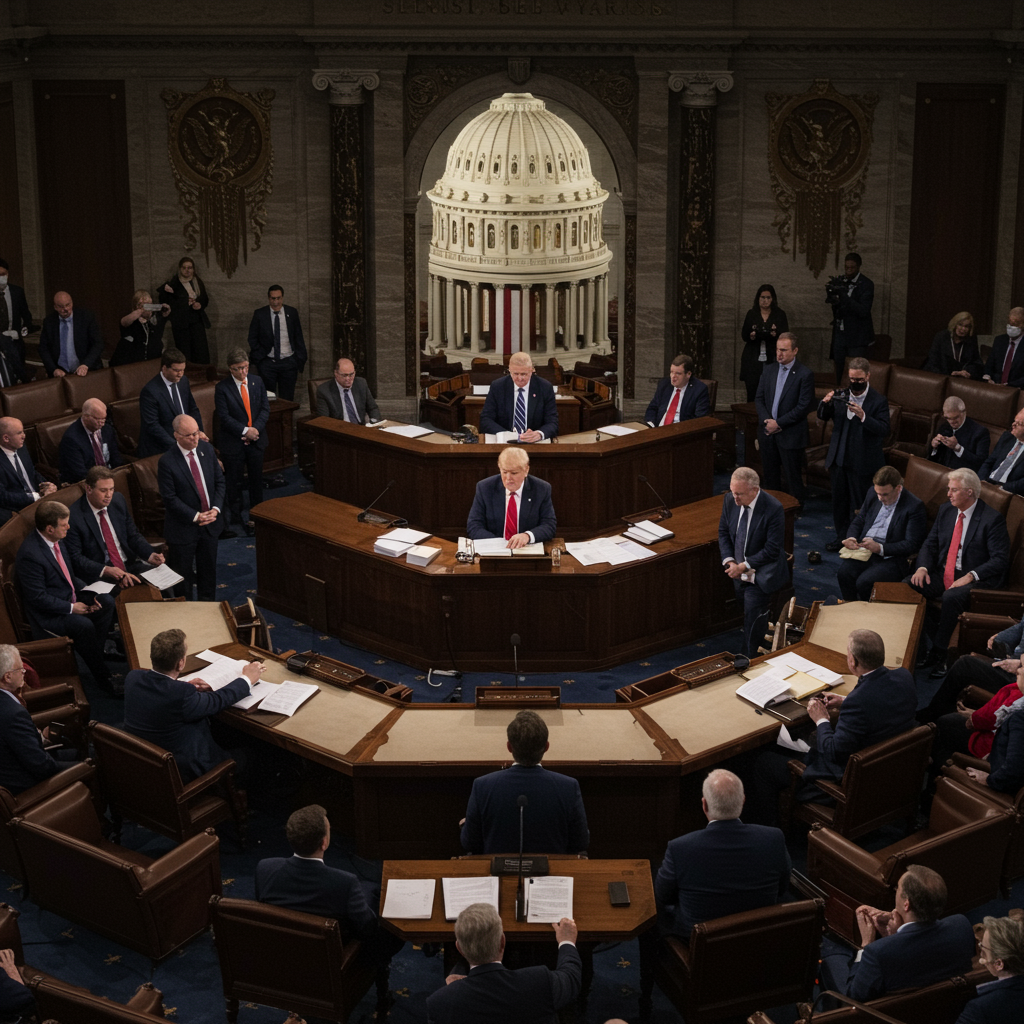Washington D.C. saw a dramatic legislative showdown this week as the U.S. house of Representatives narrowly advanced a massive spending and tax package closely tied to former President Donald Trump’s policy goals. After intense negotiations and deep internal divisions within the Republican party nearly derailed the process, the bill cleared a critical procedural hurdle, setting the stage for a final vote. This pivotal moment signals a significant step forward for the GOP leadership aiming to enact key components of Trump’s agenda, though the legislative path remains fraught with challenges.
The Pivotal House Vote
The Republican-controlled House faced a high-stakes test on Thursday. Lawmakers debated U.S. President Donald Trump’s ambitious tax and spending “megabill” deep into the night. The process was fraught with tension and uncertainty. It was nearly undone by resistance from some members of the Republican caucus.
Hours of stalemate and intricate political maneuvering defined the overnight session. Ultimately, Republican leaders successfully rallied their razor-thin majority. They overcame enough internal dissent to push the bill forward. The vote to begin the final debate in the divided House was filled with behind-the-scenes deals and shifting alliances right up to the end. House Speaker Mike Johnson played a key role in navigating these challenges. He ultimately secured enough votes to advance the bill. Only a handful of Republicans broke ranks in a vote that largely followed party lines.
Speaker Johnson addressed reporters late Wednesday night. He expressed optimism following the difficult path to the procedural vote. “It’s been a long, productive day,” Johnson stated. “We’ve been talking with members from across the conference. We’re making sure everyone’s concerns are addressed and questions are answered.” He added, “It’s been a good day. We’re in a good place right now. We feel very good about where we are, and we’re going to be moving forward.” Meanwhile, President Trump weighed in forcefully from his Truth Social platform overnight. He lashed out at dissenters within his party. “FOR REPUBLICANS, THIS SHOULD BE AN EASY YES VOTE,” Trump posted. He added, “RIDICULOUS!!!” This underscored the pressure on GOP lawmakers to support the package.
A Bill of Broad Scope: What’s Inside?
Dubbed the “One Big Beautiful Bill Act” by President Trump, this legislative package is vast. It encompasses sweeping changes across taxation, government spending, border security, and social programs. It represents the heart of the former president’s domestic policy vision. Its passage through the House is a major win for Republicans seeking to deliver on campaign promises.
The bill, acting as a reconciliation measure, consolidates many of Trump’s core agenda items. It aims to permanently extend significant tax reductions. It seeks to reform and reduce spending on safety net programs. It also commits substantial new funds towards border enforcement. Independent estimates suggest the bill could add trillions to the national debt over the next decade. It may also lead to millions losing health coverage. However, proponents argue it will stimulate the economy and increase efficiency. Opponents decry it as a boon for the wealthy at the expense of vulnerable populations.
Key Policy Overhauls Detailed
The “megabill” includes a wide array of significant policy changes. These impact millions of Americans and reshape federal programs. The details reveal the balancing act Republican leaders attempted between various factions within the party.
Tax Provisions
A central element is the permanent extension of the core provisions from the 2017 Trump Tax Cuts and Jobs Act. These cuts are otherwise set to expire at the end of the year. The bill also includes several temporary tax adjustments championed by Trump. These include eliminating taxes on overtime pay from 2026 to 2028 and allowing a deduction for interest on car loans for vehicles made in the U.S. The child tax credit would increase to $2,500 until 2028, requiring a Social Security number. The standard deduction would also see a temporary increase through 2028. For seniors, an additional $4,000 deduction would help prevent taxation of Social Security benefits, phasing out for higher earners. A key concession addressing concerns from high-tax states is raising the cap on the state and local tax (SALT) deduction. It would increase from $10,000 to $40,000 for married couples earning up to $500,000, though this boost may be temporary depending on the final version.
Reshaping Safety Nets
To help offset the tax cuts, the bill proposes significant scaling back of government spending programs. This particularly impacts safety net programs like Medicaid and SNAP. For Medicaid, the healthcare program for low-income and disabled Americans, new work requirements would begin no later than December 31, 2026. These would mandate childless adults without disabilities to work 80 hours per month to qualify. The bill also shifts enrollment verification from annual to every six months. It adds stricter income and residency checks. Republicans frame these as addressing “waste, fraud, and abuse.” Critics warn they could lead to millions losing coverage. Estimates suggest nearly 12 million Americans could lose health coverage over the next decade due to these and other changes. The bill also adds new incentives for states not to expand Medicaid. SNAP (Supplemental Nutrition Assistance Program) reforms include increasing state financial contributions to the program’s costs if their payment error rate is too high, starting in 2028. Work requirements are also added for able-bodied enrollees without dependents.
Bolstering Border Security
Border security is a major funding priority within the bill. Substantial funds are allocated towards enforcement and immigration policy. This includes $46.5 billion specifically for completing Trump’s border wall. Another $5 billion is dedicated to Customs and Border Protection facilities. Over $6 billion is marked for hiring and retaining agents and officers. Investments in screening and surveillance technology are also included. The bill introduces or increases fees for various immigration services. This includes a $1,000 fee for asylum applications, a $550 charge for work authorization applications (renewable every six months), a $3,500 fee for sponsoring unaccompanied children, and fees for those paroled into the U.S. ($1,000) or applying for temporary protected status ($500). The bill also appropriates $12 billion to states through Homeland Security to reimburse costs related to Biden-era border actions.
Debt Ceiling and Spending Adjustments
The legislative package addresses the national debt ceiling. The House version raises the limit by $4 trillion. This allows the government to cover existing obligations and avert a potential default. The bill also targets clean energy tax credits established in the Inflation Reduction Act. It dramatically scales back or phases out these credits, including the $7,500 credit for buying electric vehicles. Credits for renewable energy projects like solar and wind will also be phased out. New projects face specific deadlines to receive credits. The bill also includes a provision to delist silencers from the National Firearms Act, effectively ending a tax on their transfer.
Student Loan and Education Impact
Significant changes are proposed for the student loan system. The bill cuts approximately $330 billion from existing programs. It eliminates current repayment options like the income-based SAVE program. A new standard repayment plan and a Republican-proposed “Repayment Assistance Plan” tied to income would replace them. Pell Grant program changes include increasing the definition of full-time attendance to 30 credit hours per year for the maximum award. It requires at least half-time enrollment (15 credit hours) for eligibility. Analysts suggest these changes could reduce aid for many students.
Divided Reactions and Path Ahead
The bill faces unified opposition from Democrats. They raise objections to welfare cuts. They also highlight perceived benefits for the ultra-rich. Rhode Island House member Gabe Amo of the Democratic Party spoke forcefully during the debate. “The top 1% are salivating over getting an extra $300,000 per year because of this dangerous bill,” Amo stated on the House floor. He warned, “Billionaires win. 17 million Americans will lose their health insurance.” Republicans, meanwhile, have accused their opposition of fearmongering. House Speaker Johnson celebrated the passage as a triumph. He used the phrase “Morning in America,” signaling a new dawn for the Republican agenda.
With House passage secured, the bill now moves to the Senate. Its journey there will be challenging. The Senate previously passed its own version of a “megabill.” That version narrowly cleared the chamber with U.S. Vice President JD Vance casting a tie-breaking vote. The Senate bill included substantial differences from the House version. These included deeper cuts to Medicaid and a higher $5 trillion debt limit increase. It also had different terms for SALT deductions and clean energy credits. These variations between the House and Senate bills require reconciliation. This process could be lengthy and difficult. Hard-line House Republicans voiced strong opposition to the Senate’s changes. They were particularly concerned about the higher increase in the national debt. Despite the internal and external opposition, President Trump has actively urged Republican unity. He has pressed for the swift passage of the legislation.
Estimated Fiscal Impact
The Congressional Budget Office (CBO) analysis casts a long shadow over the bill’s fiscal implications. The CBO estimates the package could add $3.3 trillion to federal deficits over the next decade. This projection is a major point of contention. The White House disputes the CBO’s findings. Critics also highlight CBO estimates suggesting potentially millions could lose health coverage due to the Medicaid changes. Proponents argue that the tax cuts will spur economic growth. They believe this growth will offset deficit concerns over time.
Frequently Asked Questions
What major policy changes are included in the Trump-backed bill passed by the House?
The legislative package covers several key areas. It makes permanent the 2017 Trump tax cuts and adds new temporary tax benefits like eliminating taxes on overtime. It reforms safety net programs, introducing work requirements for Medicaid and SNAP and increasing state contributions to SNAP. The bill allocates substantial funding for border security, including wall construction and personnel. It also raises the national debt ceiling and cuts clean energy tax credits. Changes to student loan programs and Pell Grants are also included.
How did this bill pass the House despite internal Republican disagreements?
The bill passed the House by an extremely narrow margin of 215-214. Passage required extensive negotiations and maneuvering by Republican leadership, including Speaker Mike Johnson, to secure enough votes from their slim majority. Despite significant concerns voiced by some conservative members, particularly regarding spending and debt levels, leadership was able to rally support, partly influenced by public calls for unity from former President Trump.
What happens next now that the “megabill” has passed the House?
After passing the House, the bill now moves to the Senate for consideration. The Senate previously passed its own version of a large legislative package with significant differences in key areas like Medicaid cuts, the debt ceiling increase, and tax provisions. The House and Senate versions must be reconciled into a single bill. This process is expected to involve further negotiations and potential revisions in the Senate before a final version can be sent back to the House for a potential final vote and then to the President’s desk.
The bill’s passage in the House marks a crucial step for President Trump’s agenda. However, significant hurdles remain in the Senate. The reconciliation process will likely involve further debate and potential changes. The ultimate fate of this sweeping legislative package remains to be determined as it continues its complex journey through Congress.




